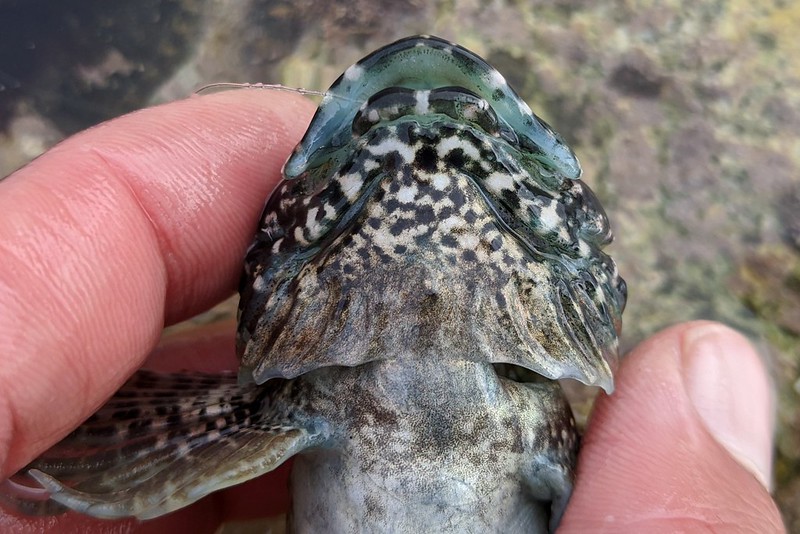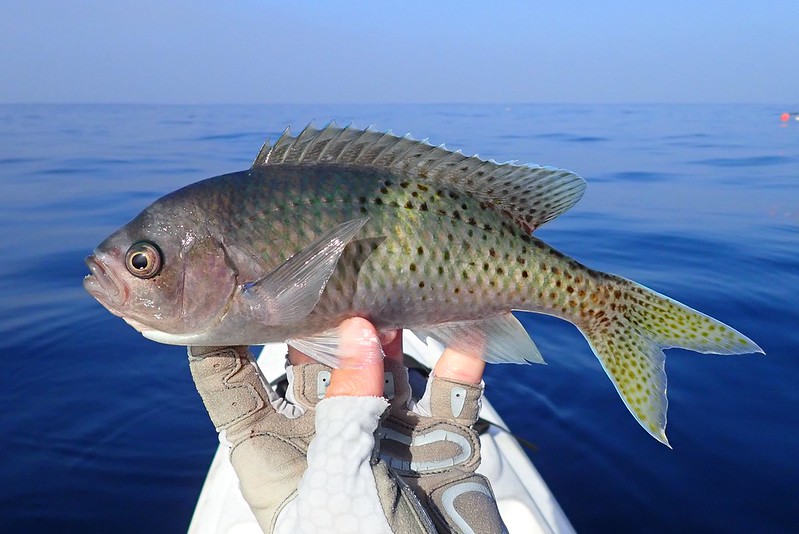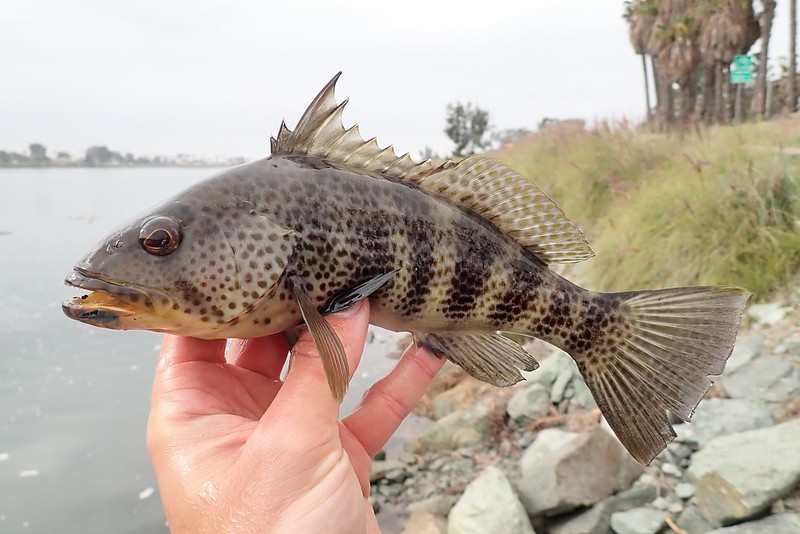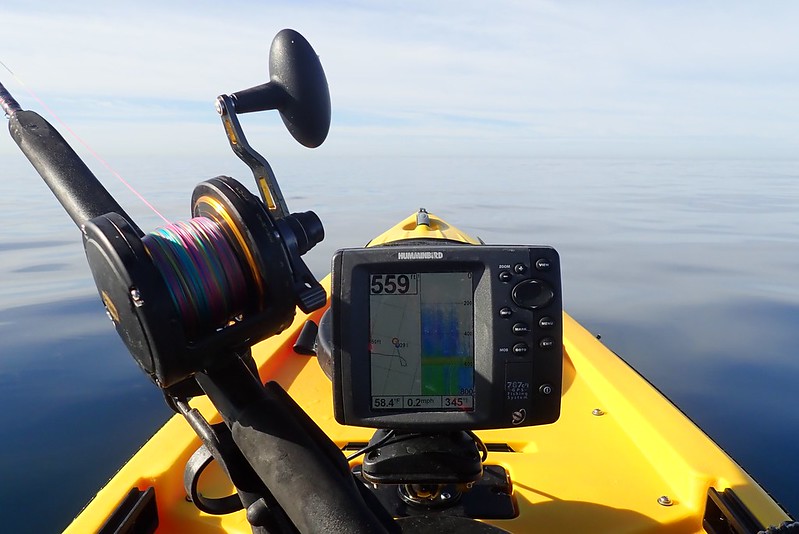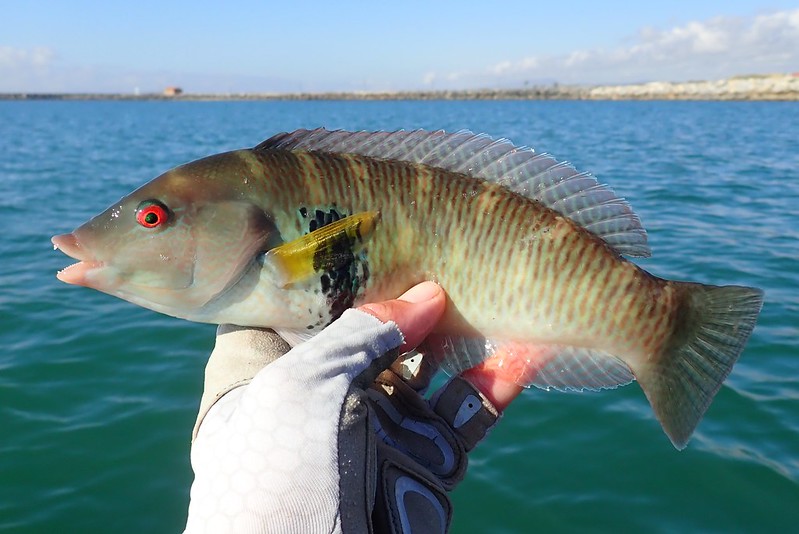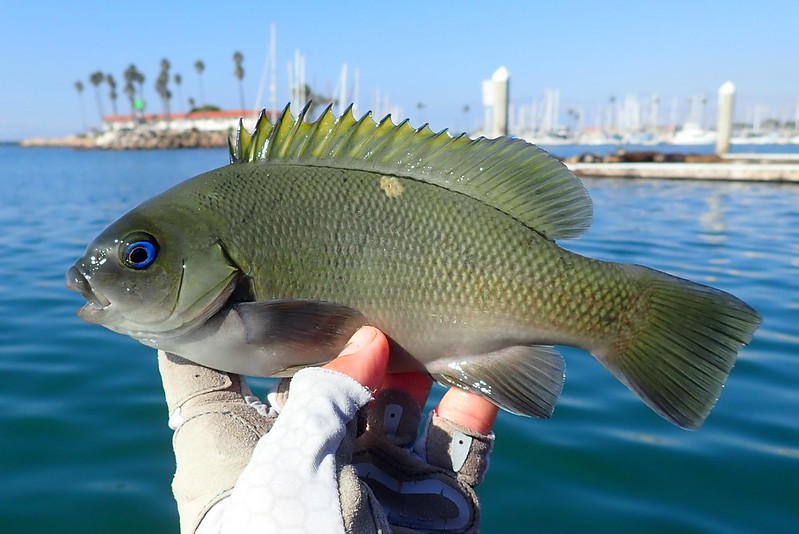Photo courtesy of Gerry Hansell.
I fished a few of the pools as well and caught woolly sculpin and rockpool blenny. One of the sculpin was especially large with nice spawning colors.
Woolly Sculpin (Clinocottus analis)
The mouth and throat of these big spawning sculpin are pretty cool. Big turquoise mouths must be sexy in the sculpin world.
We moved over to Mission Bay to pump ghost shrimp and look for cheekspot gobies with the hour or two of remaining daylight. One of the local fishing legends from the sdfish message board, Coach (Werfless), happened to be there as well. We swapped fishing stories for a bit before he headed over to the Mission Bay jetty to fish.
Gerry was the first to find a few gobies out in the open, and despite their small size they were savage biters. Gerry caught one first and then left me some room to find one for myself. At first I tried dropping my bait down into ghost shrimp burrows, and I actually did have success pulling a small goby out of one of them, but he wasn't actually hooked. When I switched to the gobies out in the open I was able to get one right away. We assumed they were cheekspot gobies, but back at home we checked my fish books and came up with shadow goby instead. Either way it was a new species!
American Shadow Goby (Quietula y-cauda) - new hook & line species #656
On Saturday we headed back down to Mission Bay, this time with kayaks. My friend Kam lent us his old Ocean Kayak Scupper Pro, and I put Gerry in my Ocean Kayak Trident 13. Gerry gifted me his old fish finder a few years ago, so I was happy to give him a chance to use it again.
Our plan was to duplicate my success fishing the wreck of the HMCS Yukon, so we made the long haul out to its GPS pin. It was an odd day with high swell but not too much wind, and despite being a little unnerved by the swell we made it out without issue. The bites came right away, and Gerry added ocean whitefish to his list, and I caught a few as well.
Ocean Whitefish (Caulolatilus princeps)
Unfortunately, from then on it was blacksmith, blacksmith, and more blacksmith. I was really hoping we'd find some perch - sharpnose seaperch for Gerry and pile or rubberlip perch for either of us. However, there was an army of blacksmith ready to intercept our offerings.
Blacksmith (Chromis punctipinnis)
At one point I thought I had a nice fish on, but it turned out to be six blacksmith on the six hooks of my sabiki, most of which had been unbaited. I found it funny that I had to work pretty hard to catch my first blacksmith two years ago, and now they were lining up to jump on my hook.
The paddle back got a little scary as we entered the Mission Bay channel. The swell had picked up, with some of the waves going straight down the channel and others reflecting off the jetty walls at various angles. We gritted our teeth and kept paddling with short fast strokes to prevent any of the waves from turning or rolling us. To make the situation more bizarre, there was an outrigger race going on at the same time. Once we were finally in the clear I hung back to get a photo of Gerry surrounded by the racers (they were significantly faster than us).
Our route looked pretty similar to my previous trip to the Yukon.
Miles: 8.83
Hours: 5:08
On Sunday we took the kayaks down to Mission Bay again, but this time we stayed inside the bay. We had plenty of good bait - ghost shrimp and live mussels - and we hoped to find a mixed bag of species like croakers, wrasse, and maybe those elusive perch. Unsurprisingly we caught mostly juvenile sand bass, but Gerry was able to add a couple new ones including rock wrasse and garibaldi.
Kelp Bass (Paralabrax clathratus)
Barred Sand Bass (Paralabrax nebulifer)
Rock Wrasse (Halichoeres semicinctus)
We also paddled over to check out the bait barge to see if there were any predators hanging around, but there was nothing going on. The sea lions were majestic as usual, surrounded by their court of birds.
Overall, kayaking didn't end up being as productive as we had hoped, but we had to remind ourselves that it was January, and fishing does tend to slow down in winter.
Miles: 3.04
Hours: 3:06
I'd heard a few rumors that there might be midshipman and staghorn sculpin in the San Diego River channel, so we headed over to check it out once the kayak gear was stowed. We ran into another sdfish member, Brandon (Cyborgstarfish), who was there looking for bass. He said the midshipmans might be there, but we'd have to go through a lot of bass to find one.
We got our baits in the water right around high tide. We did catch a few bass, but the most common fish ended up being diamond turbot, and all of them were good sized. We caught four of them in about an hour of fishing.
Diamond Turbot (Hypsopsetta guttulata)
Flatfish are bizarre. I usually forget to get a photo of the blind side of sanddabs, but for some reason with turbots I always remember.
Spotted Sand Bass (Paralabrax maculatofasciatus)
We had hoped to fish one more spot for longjaw mudsucker, yellowfin goby, California killifish, and diamond stringray, but by the time we got there the tide had already dropped too far. Feeding really only goes on there when the estuary is connected to the bay, and we arrived too late.
Despite quite a few missed targets, Gerry was still able to add ten new species to his list, which is pretty darn good by any species fisherman's standards.
- Pacific sardine
- chameleon goby
- bay blenny
- rockpool blenny
- American shadow goby
- ocean whitefish
- blacksmith
- garibaldi (incidental catch)
- rock wrasse
- diamond turbot
Thanks again Kam for loaning us your kayak, thanks Gerry for treating us to dinners, and it was good to meet both of you, Coach and Brandon! I'm looking forward to what February has in store for us!


